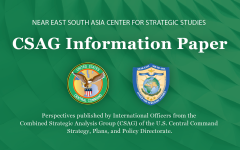Counterterrorism and Strategic Competition
July 24, 2024 2024-07-24 15:35Counterterrorism and Strategic Competition
Counterterrorism and Strategic Competition
NESA Center Alumni Publication
Syeda Tahreem Bukhari and Abdul Basit
24 July 2024
Countering terrorism was the main agenda of U.S. foreign policy after the attacks of 9/11. The war on terror lasted for almost 2 decades costing 8 trillion dollars USD while more than 900,000 people lost their lives. However, the war on terror did not end with the U.S. withdrawal of troops from Afghanistan on August 2021 as U.S. President Joe Biden affirmed the commitment to fight against terrorism would continue. The U.S. National Security Strategy 2022 has shifted focus from terrorism towards strategic competition where Russia and China are perceived as a threat to U.S. interests. This diverted attention of the U.S. from the issue of terrorism as the National Countering Terrorism strategy of the Biden administration had not even been released yet.
Following the withdrawal of U.S. troops from Afghanistan, the Taliban swiftly seized control of Kabul and established a de facto government. This abrupt transition elicited substantial concerns from the international community, especially from nations deeply invested in the Global War on Terror. The international apprehension primarily revolved around the Taliban’s proclaimed adherence to counterterrorism measures and assurances that Afghan soil would not serve as a base for terrorist activities. Initial commitments from the Taliban’s interim administration to honor international counterterrorism norms and prevent the utilization of Afghan territory for hostile actions against regional and global actors have proven largely ineffective. Over the past three years, a concerning resurgence of terrorist organizations, including Tehrik-i-Taliban Pakistan (TTP) and the Islamic State in Khorasan Province (ISIS-K), has been observed in Afghanistan. These groups have capitalized on the fragmented governance and security vacuum to establish operational sanctuaries.
The U.S. withdrawal from Afghanistan has been followed by a steady rise in terrorism threats. With the rise of terror incidents such as the ISIS attacks in Russia and Iran highlight the terrorism threat still looms and it needs world attention. French authorities foiled a terrorist attack planned for this summer’s Olympics in Paris. The U.S. and its allies are also vulnerable to such terrorist attacks, and leaving them unattended would further exacerbate the chances of these incidents.
Pakistan, an immediate neighbor and historically one of the most impacted victims of terrorism in the 21st century, has witnessed an alarming revival of terror threats emanating from Afghan soil. The TTP, exploiting the porous border and weak counterterrorism infrastructure in Afghanistan, has launched numerous attacks targeting Pakistani civilians and security personnel. These cross-border incursions underscore the failure of the Taliban regime to effectively curb terrorist activities, contradicting their earlier pledges to the international community. Global Terrorism Index 2024 ranked Pakistan at fourth in the world for deaths from terrorism. The report findings highlight the surge in terrorism incidents is parallel to the rise of Taliban in power in Afghanistan. One of the top Biden administration officials, Donald Lu also raised concerns regarding a terrible threat of terrorism faced by Pakistan from the Afghanistan border. He also suggested supporting Pakistani people in their fight against terrorism.
For the United States, the resurgence of terrorist groups in Afghanistan poses significant risks to its national security interests. The potential for Afghanistan to revert to a sanctuary for extremist organizations threatens not only regional stability but also the possibility of international terrorist plots targeting the U.S. and its allies. Recent intelligence reports suggest that elements within Afghanistan may be plotting or facilitating attacks, reanimating the specter of threats reminiscent of the pre-9/11 era. A report by the United States Institute of Peace (USIP) also highlights that the U.S. needs to invest in counterterrorism; otherwise, if a terror attack takes place against U.S. interest or on U.S. soil, it would put great pressure on the government by the masses demanding accountability and disrupting the agenda of strategic competition.
To safeguard the strategic competition and not to be diverted by the terrorist incidents, it is important to deal with the issue of terrorism. The U.S. maintains a vested interest in preventing Afghanistan from becoming a breeding ground for terrorism. Engagement with regional stakeholders is crucial to enforce counterterrorism measures and disrupt terrorist networks. In this regard, Pakistan is the most reliable partner who is the second worst victim of the war on terror. It is still committed to its fight against terrorism as evidenced by the operation Zarb-e-Istehqam recently launched by the government to curtail terrorist threats emanating from the neighboring country. Pakistan-U.S. counter-terrorism drills are commendable in this regard. The Pakistan-U.S. Infantry Rifle Company Exchange Exercise-2024 started recently, aims to exchange tactical skills in combating the menace of terrorism at the subunit level. Pakistan is the key player in the South Asia region for the U.S. to counterterrorism. The USIP report also suggests that improved relations between the U.S. and Pakistan on counterterrorism would be helpful to support the U.S. counterterrorism activities in the region.
Syeda Tahreem Bukhari: Research Officer at the Center for International Strategic Studies, AJK. She holds MPhil in Peace and Conflict Studies from National Defence University, Islamabad. She is a NESA Center for Strategic Studies Alumna. Find Syeda Tahreem Bukhari on X @Tehmii_Syed.
Abdul Basit: An Associate Research Officer at Strategic Stability Desk, Center for International Strategic Studies, AJK and is a graduate student of International Relations from National Defence University, Islamabad. He is also a NESA Center for Strategic Studies Alumnus. Find Abdul Basit on X @AbdulBa34671597.
The views presented in this article are those of the speaker or author and do not necessarily represent the views of DoD or its components.



